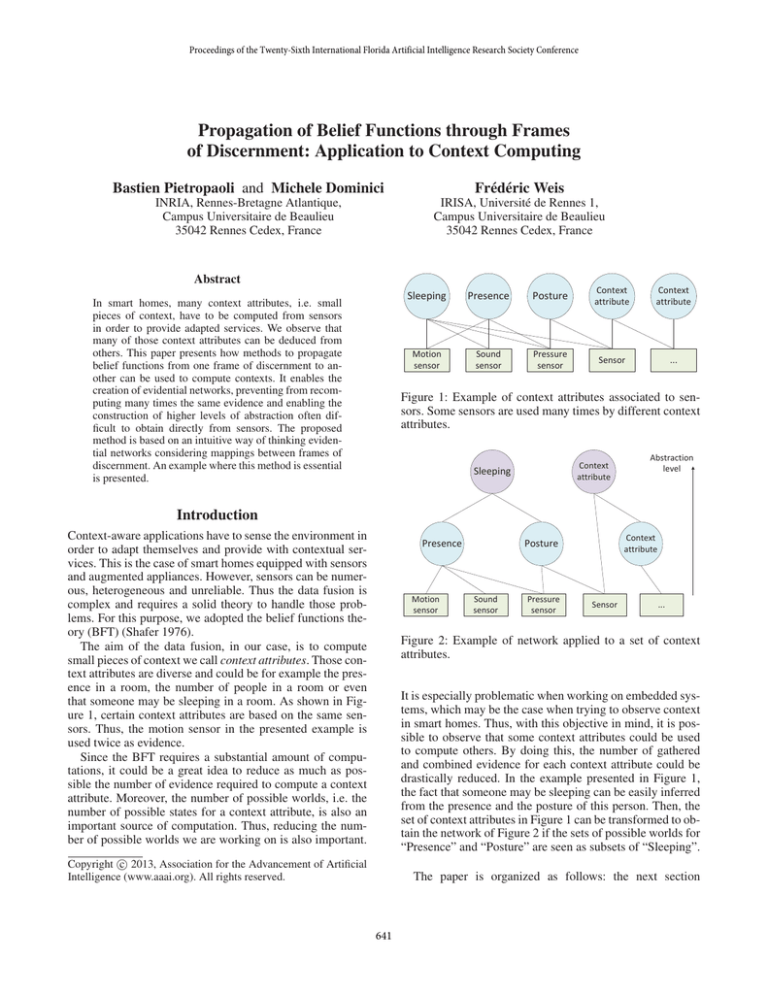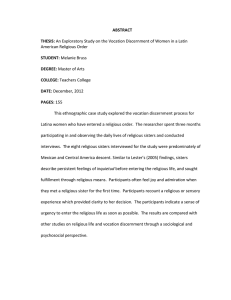
Proceedings of the Twenty-Sixth International Florida Artificial Intelligence Research Society Conference
Propagation of Belief Functions through Frames
of Discernment: Application to Context Computing
Bastien Pietropaoli and Michele Dominici
Frédéric Weis
INRIA, Rennes-Bretagne Atlantique,
Campus Universitaire de Beaulieu
35042 Rennes Cedex, France
IRISA, Université de Rennes 1,
Campus Universitaire de Beaulieu
35042 Rennes Cedex, France
Abstract
In smart homes, many context attributes, i.e. small
pieces of context, have to be computed from sensors
in order to provide adapted services. We observe that
many of those context attributes can be deduced from
others. This paper presents how methods to propagate
belief functions from one frame of discernment to another can be used to compute contexts. It enables the
creation of evidential networks, preventing from recomputing many times the same evidence and enabling the
construction of higher levels of abstraction often difficult to obtain directly from sensors. The proposed
method is based on an intuitive way of thinking evidential networks considering mappings between frames of
discernment. An example where this method is essential
is presented.
Sleeping
Presence
Posture
Context
attribute
Context
attribute
Motion
sensor
Sound
sensor
Pressure
sensor
Sensor
...
Figure 1: Example of context attributes associated to sensors. Some sensors are used many times by different context
attributes.
Context
attribute
Sleeping
Abstraction
level
Introduction
Context-aware applications have to sense the environment in
order to adapt themselves and provide with contextual services. This is the case of smart homes equipped with sensors
and augmented appliances. However, sensors can be numerous, heterogeneous and unreliable. Thus the data fusion is
complex and requires a solid theory to handle those problems. For this purpose, we adopted the belief functions theory (BFT) (Shafer 1976).
The aim of the data fusion, in our case, is to compute
small pieces of context we call context attributes. Those context attributes are diverse and could be for example the presence in a room, the number of people in a room or even
that someone may be sleeping in a room. As shown in Figure 1, certain context attributes are based on the same sensors. Thus, the motion sensor in the presented example is
used twice as evidence.
Since the BFT requires a substantial amount of computations, it could be a great idea to reduce as much as possible the number of evidence required to compute a context
attribute. Moreover, the number of possible worlds, i.e. the
number of possible states for a context attribute, is also an
important source of computation. Thus, reducing the number of possible worlds we are working on is also important.
Presence
Motion
sensor
Context
attribute
Posture
Sound
sensor
Pressure
sensor
Sensor
...
Figure 2: Example of network applied to a set of context
attributes.
It is especially problematic when working on embedded systems, which may be the case when trying to observe context
in smart homes. Thus, with this objective in mind, it is possible to observe that some context attributes could be used
to compute others. By doing this, the number of gathered
and combined evidence for each context attribute could be
drastically reduced. In the example presented in Figure 1,
the fact that someone may be sleeping can be easily inferred
from the presence and the posture of this person. Then, the
set of context attributes in Figure 1 can be transformed to obtain the network of Figure 2 if the sets of possible worlds for
“Presence” and “Posture” are seen as subsets of “Sleeping”.
c 2013, Association for the Advancement of Artificial
Copyright Intelligence (www.aaai.org). All rights reserved.
The paper is organized as follows: the next section
641
Even if this method does not create perfect beliefs, it enables the use of many sensors to build evidence on context
attributes. The imperfections are then compensated by the
accumulation of evidence.
presents the basics of the BFT required to understand the
presented methods and their advantages; it is followed by
the presentation of methods used to propagate belief functions. An example where the application of these methods is
useful is then presented. Finally, the paper is concluded.
Accumulating evidence
Basics of BFT
The theory of belief functions is about accumulating evidence on what is going on. To do this, the most common
rule of combination is the Dempster’s rule given by:
X
1
m1 ⊕ m2 (A) =
m1 (B)m2 (C)
(3)
1−K
B∩C=A6=∅
X
with K =
m1 (B)m2 (C)
(4)
In this section, we present only the basics required to understand the propagation of belief functions from one frame of
discernment to another and the interest of doing so.
Frame of Discernment
In the BFT (Shafer 1976), the first thing that should be defined is a set of possible “worlds” called the frame of discernment. It is often noted:
Ω = {ω1 , ω2 , ..., ωn }
B∩C=∅
This combination rule offers a quick convergence when
evidence is not in conflict. However, its complexity is not
acceptable for embedded systems if the number of possible
worlds increases too much and if many mass functions have
to be combined altogether. There exist many other rules of
combination in the literature. A generalization is also proposed by E. Lefevre et al. (Lefevre, Colot, and Vannoorenberghe 2002). Unfortunately, the complexity of all these
rules is equivalent or even worse than the complexity of
Dempster’s rule. The reduction of the size of frames of discernment we are working on and the reduction of the number of combinations of evidence is thus an advantage for all
these rules.
(1)
These worlds have to be exclusive (i.e. ωi ∩ ωj = ∅ if
i=
6 j) and if possible exhaustive meaning that the true state
of the world has always been defined. To give an example, we can define a set of possible postures for someone as
Ω = {Seated, Standing, LyingDown}. In our work, each
context attribute is represented by a frame of discernment.
Mass Function
Once the frame of discernment is created, a mass function
representing the degree of belief associated to each subset
of Ω is defined such that:
m : 2Ω 7−→ [0, 1]
X
m(A) = 1
Propagation of belief functions
The idea of optimizing the computations required by belief
functions by dividing the frame of discernment in subsets is
not new (Shafer, Shenoy, and Mellouli 1987). In this section,
we present a common method consisting in the propagation
of belief functions based on a simple “one-to-one” correspondence between subsets of possible worlds but also how
evidential mappings enable the use of heuristic knowledge
links between frames of discernment.
(2)
A⊆Ω
Each subset A ⊆ Ω with m(A) > 0 is called a focal element. When a focal element contains several worlds, the
degree of belief given by the mass function cannot be distributed in any way between those worlds. The degree of
belief is thus completely associated to the fact that the true
state of the world is contained in the focal element but cannot be more specific. Thus, the mass function can represent
uncertainty using degrees of belief but also imprecision using non-atomic subsets of Ω. Those mass functions are used
to express uncertainty on which “world” is the true state of
a context attribute.
Vacuous extension of frames
Let’s consider two frames of discernment Ω and Θ supposed
to describe the same context attribute. Let m be a mass function defined on the frame Ω that we want to propagate to the
frame Θ. We can now consider the two possible cases: either
card(Ω) ≤ card(Θ), either card(Θ) ≤ card(Ω). In simple
words, one frame of discernment is more precise than the
other.
In the first case, as both frames describe the same set of
possible worlds, the elements of Ω are unions of elements
of Θ (i.e.
S for each A ⊆ Ω, there exist Bi ∈ Θ such that
A = Bi ). The propagation of m to Θ is then called the
vacuous extension of m and is denoted by m↑Θ . It is given
by:
m(B) if A = B ⊆ Ω
, ∀A ⊆ Θ (5)
m↑Θ (A) =
0
otherwise.
Building mass functions
To build mass functions, it is possible to use methods exploiting statistics (Aregui and Denoeux 2008). However, we
wanted a method requiring only few experiments.
As described in (Pietropaoli, Dominici, and Weis 2012),
for each couple (sensor/context attribute), we build a set of
mass functions associating a mass function to any raw data
given by a sensor. The set of mass functions is built after few
experiments by observing the sensor behavior. It could be
also totally based on intuition as human beliefs. (For more
details on how this building method and the way it can be
improved, please refer to (Pietropaoli, Dominici, and Weis
2012)).
This propagation brings no new evidence and the two mass
functions are strictly equivalent in terms of information.
642
To illustrate the propagation presented here, we can consider the two frames Ω = {yes, no} associated to the presence in a room and Θ = {0, 1, 2+} associated to the number
of people in the same room (where “2+” means “two or more
people”). It is easy to create a direct transformation of subsets of Ω into subsets of Θ. For example, we could have the
following correspondence:
a bed. Anyway, the likelihood that someone may be sleeping
while lying down is way higher than if he or she is standing
or even seated...
Evidential mappings enable the use of heuristic knowledge to create a link between frames of discernment (Liu,
Hughes, and McTear 1992). Thus, it is possible to propagate
belief from any frame of discernment to another if there exists any known link between those frames.
The idea here is thus to create some kind of mass function
on Θ for each subset of possible worlds of Ω. For example,
we could define a mass function on the fact that the person
may be sleeping, knowing that he or she is seated:
{yes} = {1 ∪ 2+}
{no} = {0}
As a consequence, it is possible to transform mass functions
using the presented operations. For example, consider the
following mass function
m({yes}|Seated) = 0.1
m({no}|Seated) = 0.7
m({yes ∪ no}|Seated) = 0.2
m({yes}) = 0.3
m({no}) = 0.1
m({yes ∪ no}) = 0.6
This mass function corresponds to the heuristic knowledge
linking the value “Seated” of the context attribute “Posture”
to the context attribute “Sleeping”. Since it is defined as
a mass function, it is possible to use any already existing
method to build mass functions such as methods based on
intuition (Pietropaoli, Dominici, and Weis 2012) or methods
based on statistics (Aregui and Denoeux 2008) by observing the correlation between the worlds in different frames of
discernment.
By defining such a mass function for each nonempty subset of Ω, we obtain the Basic Matrix (BM) that characterizes
completely the propagation of mass functions defined on Ω
to the frame of discernment Θ.
Let’s now consider a general case with Ω =
{ω1 , ω2 , ..., ωn } and Θ = {θ1 , θ2 , ..., θk }, two frames of
discernment. The BM, in our case, is defined by:
m({θ1 }|ω1 ) · · · m({θ1 }|Ω)
..
..
..
MΩ→Θ =
(8)
.
.
.
m({Θ}|ω1 ) · · · m({Θ}|Ω)
By using the vacuous extension, it would become
m↑Θ ({1 ∪ 2+}) = 0.3
m↑Θ ({0}) = 0.1
m↑Θ ({0 ∪ 1 ∪ 2+}) = 0.6
Restriction of frames
In the second case, as Θ is less precise than Ω, the propagation of m to Θ is equivalent to the conditioning of m given
by:
P
for A ⊆ B
C⊆B̄ m(A ∪ C)
m(A|B) =
(6)
0
otherwise.
Let m↓Θ denote the restriction of m to Θ, then it is given
by:
m↓Θ (A) = m(A|Θ)
(7)
As elements of Θ, in this case, are unions of elements of Ω,
the resulting mass function can be less informative than the
original one.
Those two ways of propagating belief functions from one
frame to another are based on the direct correspondence that
exists between the elements of the two frames. Those tools
are very useful if it is possible to divide a huge frame of
discernment in subsets of possible worlds. However, in some
cases, the link between frames of discernment is not trivial
and requires a more flexible approach.
The element of the BM denoted by MΩ→Θ (A, B) with A ⊆
Θ and B ⊆ Ω corresponds to m(A|B)
The propagation of any mass function m defined on Ω
to Θ is obtained using the following formula for each A,
∅ 6= A ⊆ Θ:
X
m(B)MΩ→Θ (A, B)
(9)
mΩ→Θ (A) =
B⊆Ω
The empty set is considered as a special case where the
propagation of its mass always results in a mass given to
itself. Thus we always have:
Evidential mappings
As previously seen, some context attributes can be linked
and it is possible to infer belief on a frame of discernment
from belief on another frame of discernment. Unfortunately,
the vacuous extension and the coarsening are valid only if
one frame is a subset of the other one.
For instance, if we consider the posture of someone, defined by the frame Ω = {Seated, Standing, LyingDown}
and if that person is sleeping, defined by Θ = {yes, no},
it is not easy to create a direct correspondence between the
worlds. As a matter of fact, a person could be sleeping seated
in a sofa or reading a book, thus not sleeping, lying down on
mΩ→Θ (∅) = m(∅)
(10)
n+k
In terms of computability, the worst case is in O(2
)
where n and k are the number of possible worlds defined in
the two frames Ω and Θ respectively. However, in terms of
implementation, as it is possible to consider only the focal
elements of mass functions (Osswald 2012), it is possible
to get rid of all the zeros of the basic matrix. The complexity increases with the “complexity” of heuristic knowledge
linking the frames of discernment.
643
Subsets
{Se}
{St}
{Ly}
{Se ∪ St}
{Se ∪ Ly}
{St ∪ Ly}
{Se ∪ St ∪ Ly}
{yes}
0.1
0
0.8
0
0.1
0
0
{no}
0.7
1
0
0
0.5
0
0
{yes ∪ no}
0.2
0
0.2
1
0.4
1
1
Table 1: Basic matrix linking the posture of someone to the fact that he or she may be sleeping. “Se”, “St” and “Ly” stands for
“Seated”, “Standing” and “LyingDown” respectively.
Example: Posture→ Sleeping
• they are completely independent of any combination rule
and any decision making process.
Keeping in mind that context inference asks for computing dozens of context attributes for a smart home, if possible
within a sensor network or a sensor node network with very
limited computation capabilities, the effective gain has to be
tested with a high scale evidential network. Since an implementation of the theory is already working, testing it on high
scales will eventually be a subject of interest in future work.
Let’s now come back to our example of propagating the belief on the posture of someone to the fact that he or she may
be sleeping. We can use the basic matrix shown in Table 1.
Let’s take an example mass function defined on the posture
of someone:
m({Seated}) = 0.4
m({LyingDown}) = 0.1
m({Seated ∪ LyingDown}) = 0.2
m({Ω}) = 0.3
Acknowledgments
The authors would like to thank EDF that has funded this
research and Guérain Le Bars from Université de Rennes 1
(France) for his contribution to this work during his internship. Thanks also to Nathanaël Prémillieu and Benjamin
Lesage for their remarks and the discussion about this work.
If we propagate this mass function to the fact that the person
may be sleeping, we obtain:
mΩ→Θ ({yes})
=
=
mΩ→Θ ({no}) =
=
mΩ→Θ ({Θ}) =
0.4 ∗ 0.1 + 0.1 ∗ 0.8 + 0.2 ∗ 0.1
0.14
0.4 ∗ 0.7 + 0.2 ∗ 0.5
0.38
0.48
References
Aregui, A., and Denoeux, T. 2008. Constructing consonant belief functions from sample data using confidence sets
of pignistic probabilities. International Journal of Approximate Reasoning 49:575–594.
Denoeux, T. 2006. The cautious rule of combination for belief functions and some extensions. In Information Fusion,
2006 9th International Conference on, 1 –8.
Lefevre, E.; Colot, O.; and Vannoorenberghe, P. 2002. Belief
function combination and conflict management. Information
Fusion 3(2):149–162.
Liu, W.; Hughes, J. G.; and McTear, M. F. 1992. Representing heuristic knowledge in d-s theory. In Proceedings of the
Eighth international conference on Uncertainty in artificial
intelligence, UAI’92, 182–190. San Francisco, CA, USA:
Morgan Kaufmann Publishers Inc.
Osswald, C. 2012. Controling the number of focal elements
- some combinatorial considerations. In Denoeux, T., and
Masson, M.-H., eds., Belief Functions, volume 164 of Advances in Soft Computing, 135–143. Springer.
Pietropaoli, B.; Dominici, M.; and Weis, F. 2012. Belief
inference with timed evidence. In Belief Functions: Theory
and Applications, volume 164 of Advances in Intelligent and
Soft Computing. Springer Berlin / Heidelberg. 409–416.
Shafer, G.; Shenoy, P. P.; and Mellouli, K. 1987. Propagating
belief functions in qualitative markov trees. Int. J. Approx.
Reasoning 1(4):349–400.
Shafer, G. 1976. A Mathematical Theory of Evidence.
Princeton: Princeton University Press.
In this example, m is quite indecisive on the posture of the
person, thus mΩ→Θ is indecisive as well.
In the example given in Figure 2, the mass functions of the
“Posture” and the “Presence” are themselves the result of a
combination of mass functions based on sensor measures.
They are propagated to the frame of discernment “Sleeping”
and can be combined using any combination rule.
If one is concerned with the independence of evidence,
for example when a sensor has been used twice or more to
compute context attributes, the cautious rule of combination
may be helpful (Denoeux 2006).
Conclusion
In this paper, we presented an approach of the evidential
network for the computation of context attributes. The presented methods have many advantages:
• they enable the construction of higher level abstractions
sometimes difficult to obtain directly from sensors or using joint mass functions;
• they reuse evidence by propagating entire mass functions
from a level of abstraction to another;
• they enable the computation of beliefs on huge sets of possible worlds by dividing them in smaller subsets;
• they are flexible in the way it is built, based on statistics
or on few experiments and intuition;
644



